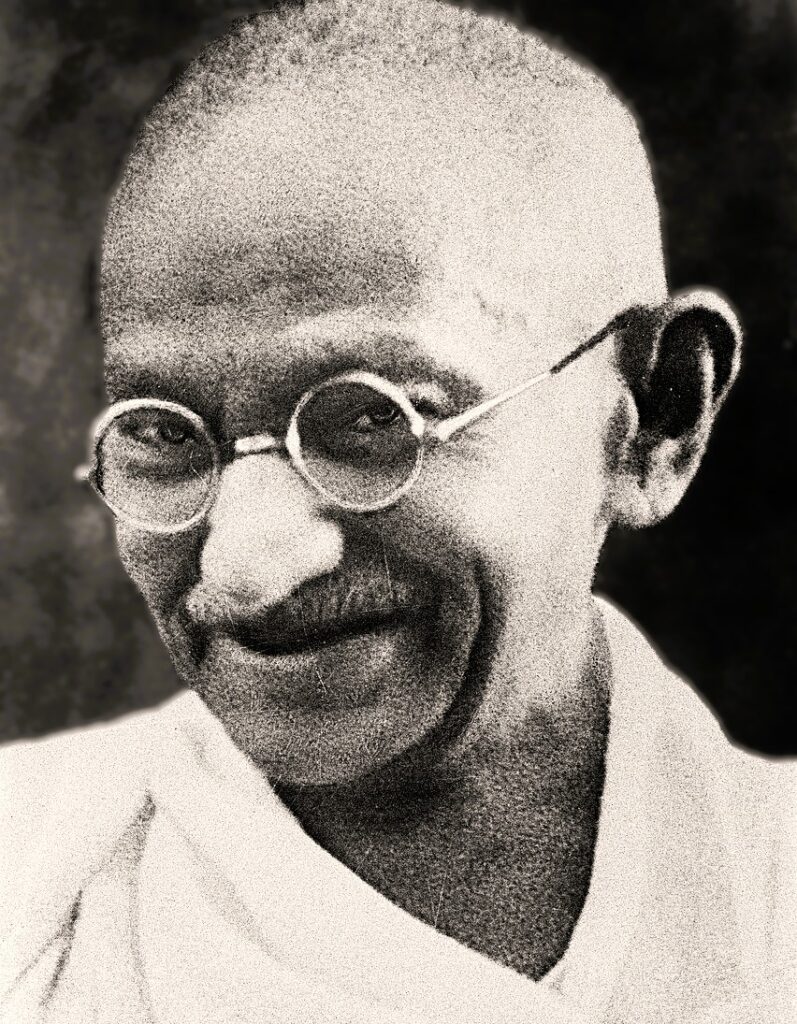Mahatma Gandhi, one of the most revered leaders in the world, played a pivotal role in India’s struggle for independence from British rule. His philosophy of non-violence (Ahimsa) and truth (Satya) inspired not just Indians but also individuals across the globe, and his ideas continue to resonate today.
Early Life and Education
Born on October 2, 1869, in Porbandar, a coastal town in present-day Gujarat, Mohandas Karamchand Gandhi was the youngest of four children. His father was a high-ranking government official, and his mother, a deeply religious woman, instilled in him strong ethical values from a young age.
Gandhi went to London to study law in 1888, where he earned a degree in law and became a barrister. His time in London also exposed him to the works of philosophers like Henry David Thoreau and Leo Tolstoy, who had a profound influence on his thinking about non-violent resistance.

Gandhi’s Early Struggles and the South African Experience
In 1893, Gandhi traveled to South Africa to work as a lawyer. It was here that he first experienced racial discrimination, which deeply affected him and shaped his later philosophy. After being thrown off a train for sitting in a “whites-only” compartment, Gandhi began to fight for the rights of Indians and other non-Europeans in South Africa.
During his 21 years in South Africa, he organized campaigns for civil rights, leading protests against discriminatory laws. His methods of peaceful resistance, including strikes, boycotts, and passive resistance (Satyagraha), were refined during this period, laying the groundwork for his future campaigns in India.
The Return to India and the Fight for Independence
Gandhi returned to India in 1915, at a time when the country was undergoing significant social and political turmoil. The Indian independence movement, led by various groups, was gaining momentum against British colonial rule. Gandhi, with his newfound belief in non-violence and truth, became the leader of the Indian National Congress (INC), which was at the forefront of the struggle.
One of his first major campaigns in India was the Champaran Satyagraha in 1917, where he successfully fought for the rights of farmers in Bihar who were being exploited by British landlords. This marked the beginning of his leadership in the freedom movement.
Non-Violent Resistance and Major Movements
Gandhi’s approach to resistance, based on non-violence and peaceful civil disobedience, became the hallmark of India’s independence struggle. He believed that people must fight against injustice through peaceful means rather than violence, which would only perpetuate more violence.
- Non-Cooperation Movement (1920-1922): After the Jallianwala Bagh massacre of 1919, where hundreds of innocent Indians were killed by British troops, Gandhi called for the Non-Cooperation Movement. He urged Indians to boycott British goods, schools, and services, and to refuse to pay taxes. The movement spread like wildfire but was called off by Gandhi after the violence at Chauri Chaura in 1922, where protesters killed police officers.
- Salt March (1930): One of Gandhi’s most iconic acts of resistance was the Salt March, or Dandi March, in 1930. Protestors defied the British salt tax by walking 240 miles to make their own salt. This peaceful march gained worldwide attention and became a symbol of defiance against British rule.
- Quit India Movement (1942): During World War II, Gandhi launched the Quit India Movement, demanding an immediate end to British rule in India. Though the movement was suppressed, it intensified the demand for independence.
The Path to Independence and Partition
Gandhi’s unwavering commitment to non-violence led him to attempt to broker peace between Hindus and Muslims during the tense period leading to independence. He advocated for unity between the two communities and warned against the dangers of partition, which would divide India into Hindu-majority India and Muslim-majority Pakistan. Despite his efforts, the partition took place in 1947, leading to widespread violence, mass migrations, and deep-rooted division.
Assassination and Legacy
Gandhi’s life came to a tragic end on January 30, 1948, when he was assassinated by Nathuram Godse, a Hindu nationalist who opposed Gandhi’s efforts to reconcile Hindus and Muslims. Gandhi’s assassination shocked the world, but his legacy lived on.
Gandhi’s teachings of non-violence and peaceful resistance influenced many global leaders, including Martin Luther King Jr., Nelson Mandela, and Cesar Chavez. His philosophy continues to inspire social movements worldwide, advocating for justice, peace, and equality.
Conclusion
Mahatma Gandhi’s life was one of deep commitment to truth, non-violence, and social justice. His role in India’s independence movement, his dedication to ethical principles, and his philosophy of Satyagraha have left an indelible mark on the world. As we reflect on his life, it serves as a reminder that the fight for justice must be rooted in peace, and that one individual’s dedication to truth and non-violence can change the course of history.



